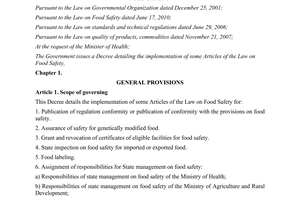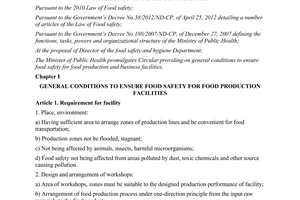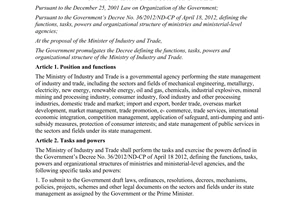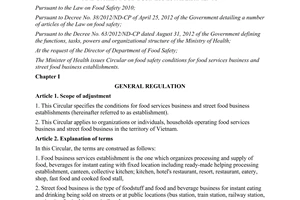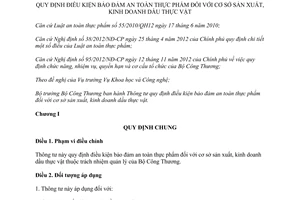Circular No.59/2014/TT-BCT food safety conditions for vegetable oil production and trading establishments đã được thay thế bởi Circular 27/2016/TT-BCT abrogation legislative documents regulatory requirements for investment và được áp dụng kể từ ngày 20/01/2017.
Nội dung toàn văn Circular No.59/2014/TT-BCT food safety conditions for vegetable oil production and trading establishments
|
THE
MINISTRY OF INDUSTRY AND TRADE |
SOCIALIST
REPUBLIC OF VIETNAM |
|
No.: 59/2014/TT-BCT |
Hanoi, December 22, 2014 |
CIRCULAR
REGULATING FOOD SAFETY CONDITIONS FOR VEGETABLE OIL PRODUCTION AND TRADING ESTABLISHMENTS
Pursuant to the Law on Food Safety No. 55/2010/QH12 dated June 17, 2010;
Pursuant to the Government's Decree No. 38/2012/NĐ-CP dated April 25, 2012, detailing the implementation of some articles of the Law on Food Safety;
Pursuant to the Government's Decree No. 95/2012/NĐ-CP dated November 12, 2012 defining the functions, tasks, entitlements and organizational structure of the Ministry of Industry and Trade;
At the request of Director General of Department of Science and Technology;
The Minister of Industry and Trade promulgates the Circular regulating food safety conditions for vegetable oil production and trading establishments.
Chapter I
GENERAL PROVISIONS
Article 1. Governing scope
This Circular regulates food safety conditions for vegetable oil production and trading establishments under the management of the Ministry of Industry and Trade.
Article 2. Regulated entities
1. This Circular applies to:
a) Vegetable oil production and trading establishments;
b) Competent state management agencies and organizations, individuals involved in vegetable oil production and trading;
2. This Circular does not apply to:
a) Small vegetable oil production and trading establishments;
b) Food and beverage service and street food business establishments within the governing scope of the Ministry of Health’s Circular No. 30/2012/TT-BYT dated December 05, 2012 regulating food safety conditions for food and beverage services, street food business establishments.
Article 3. Interpretation of terms
In this Circular, some terms are construed as follows:
1. Vegetable oil production establishment means an establishment that carries out one, some or all of the activities of preliminary processing, processing (cleaning, drying, pressing, extraction and refining), packaging and storage to produce finished vegetable oil product.
2. Crude vegetable oil production establishment means an establishment that carries out production of vegetable oil without going through the process of refining and creating finished products.
3. Vegetable oil trading establishment mean an establishment that carries out introduction, storage, transport, purchase and sale of vegetable oil products.
4. Small vegetable oil production and trading establishment means an establishment that is owned by an individual, a group of individuals and households as registered business households and is not granted Certificate of business registration or Certificate of enterprise registration, or Investment certificate according to the law provisions.
Article 4. General provisions for vegetable oil production and trading establishments
Food and beverage services establishments, street food shops within the governing scope of the Ministry of Health’s Circular No. 30/2012/TT-BYT dated December 05, 2012 regulating food safety conditions for food and beverage services, street food business establishments.
Chapter II
FOOD SAFETY CONDITIONS FOR VEGETABLE OIL PRODUCTION AND TRADING ESTABLISHMENTS
Article 5. Vegetable oil production establishments
1. Production location
a) Constructed under current planning approved by competent state agencies;
b) Located far away from sources of pollution, toxicity that may impose bad effects on food safety quality of vegetable oil products;
c) Have an area sufficient for arranging production line in accordance with the establishment’s capacity design ensuring phases of production meet technological requirements and industrial hygiene measures.
2. Arrangement and design of factory
a) Layout of production line must be arranged to appropriate wind direction to avoid adverse effects of sources of pollution such as boiler’s exhaust gas, wastewater treatment stations, solid waste and waste oil storage area, sanitary facilities and other sources of pollution;
b) Factory must be designed on a one-way rule from in-coming raw material all the way to the final product as vegetable oil product;
c) Separation must be set up to avoid cross-contamination between the areas such as warehouse (raw material, ancillary material, product processing and preserving aids), production area (preliminary processing, cleaning, drying, pressing, extraction, refining, filling and product finishing, clean-in-place (CIP), dynamics), solid waste storage area, wastewater and waste oil collection system and utilities;
d) Internal road system must be designed and constructed in such a way to ensure durability, strength and no generation of dust. Walkways high above must be installed with handrails to ensure labor safety;
dd) Water drainage system (industrial wastewater, domestic wastewater and rainwater) must be designed and constructed separately, with cover and in such a way to ensure proper slope for drainage.
3. Structure of factory
a) Floor of production area must ensure good drainage and be made from material that is durable, anti-slip and easy to clean. Water drainage system in the production area must be designed with cover;
b) Manholes and water collection pit must be designed with odor and insect trap to prevent microorganisms from penetrating into the factory;
c) Piping system (pipes of vegetable oil, pipes for directing and recovering solvents, cleaning equipment) must be designed and manufactured from appropriate materials, painted in different colors and distinguishable instructions.
4. Ventilation system
a) Factory must be designed with air outlets to ensure circulation of air, enable elimination of heat and air generated during the production;
b) Area of drying and extraction must be well-ventilated to ensure suitable ambient temperature and labor safety according to the regulations;
c) Raw material pressing area must be designed with a dust collector and an appropriate ventilation system to ensure proper operation and no generation of pollution to other phases of production;
d) Oil refining area must be designed in such a way to ensure sufficient ventilation, quick elimination of heat and odor;
dd) Filling area must be kept constantly dry, ventilated and clean;
5. Steam, heat and compressed air supply system
a) Boilers must be designed and manufactured from appropriate materials, arranged in an area separate from production area, and be subject to regular inspections and assessment according to applicable regulations;
a) Steam and compressed air supply pipeline must be designed and manufactured from appropriate materials, installed in such a way to ensure safety with signs or instructions distinguishable from other pipelines, be subject to regular inspections and assessment according to applicable regulations;
6. Waste, wastewater and exhaust gas collection and treatment system
a) Solid waste
- Waste oil after pressing and extraction must be collected into a separate area with an area appropriate with design capacity of the production line, cleaned every 48 hours for avoidance of cross-contamination during the production;
- Papers, labels, empty bottles, cans, barrels, damaged caps and other solid waste during the production must be collected and stored in a suitable container located in a noticeable position to ease collection and treatment and generate no adverse effect on the production;
- Waste generated in the utilities area, domestic waste must be collected, classified and stored in a separate area for treatment;
- Solid waste must be treated by organizations or individuals that are permitted by competent state management agencies to operate in environmental remediation;
b) Industrial and domestic wastewater
- Industrial and domestic wastewater treatment area must be separated from production area and located upwind;
- Capacity and treatment technology must be in conformable to the discharge flow of peak load of the production establishment and ensure that treated wastewater achieve environmental standard;
c) Exhaust from production area and boiler system must be properly treated to prevent effects on other production areas;
d) Hazardous waste
- Must be collected, stored, transported and treated according to applicable regulations;
- Must be managed and treated by organizations or individuals that are permitted by competent state management agencies to operate in environmental remediation for hazardous wastes.
7. Stores
a) General requirements for stores (raw material, preservation of crude vegetable oil, food additives, processing aids, materials, packages and finished products) are as follows:
- Ensure storage capacity meets design capacity of production line;
- Ensure regular maintenance and cleaning as required by the establishment;
- Meet all conditions for storage according to the establishment’s instruction or regulations;
- Prevent infestation, rodents and other harmful agents;
- Have information to recognize each type of raw material, preserved crude vegetable oil, food additives, processing aids, materials, packages and finished products stored, have documents to follow up dispatches and receipts of goods at each store.
b) Stores of chemicals must suit requirements and conditions for preservation according to the establishment’s regulations and applicable regulations on chemical storage;
c) Finished product store
In addition to the provisions set out in Point a, Clause 7 hereof, the finished product store must:
- Ensure humidity and temperature suit each type of vegetable oil, avoidance of direct exposure of products to sunlight;
- Must have all information about name of product, production batch, production date, production shifts and other information as stipulated by the establishment;
- Must have a separate area to temporarily store unsatisfactory products pending treatment.
8. Vegetable oil production area
a) Raw material must be preserved in stores or silos to ensure quality safety;
b) Any chemical used for preservation of raw material and production of vegetable oil must be defined in permissible list according to applicable regulations and imposes no negative effect on quality and food safety of the product;
c) Phase of cleaning and temporarily processing raw material
- Any raw material prior to being put into production must be inspected for residues of pesticides, toxic molds and fungi, heavy metals; Only raw material meeting requirements for quality and food safety is used for vegetable oil production;
- Raw material must undergo complete removal of dirt, stone, sand, metals and other impurities before it is put into pressing and extraction.
d) The phase of pressing, extraction and recovery of crude vegetable oil must ensure no contamination and cross-contamination with insects, dirt, waste oil and other sources of pollution. Quality and residual solvents must be controlled.
9. Finished vegetable oil production area
a) Refining must ensure removal of harmful substances dissolved in crude oil in order not to degenerate nutrients and quality of vegetable oil;
b) Filling
- Filling area must be separate from other production areas; equipment control shall be carried out prior to production shift to ensure the equipment constantly works well;
- Filling process must be observed by equipment or human to ensure quantity, quality and food safety.
c) Product finishing phase
- Finished vegetable oil shall be recorded and divided into production shifts or cycles. Each batch must be inspected for quality, organoleptic, packaging and labels before receipts or dispatches from stores to ensure food quality and safety before distribution and circulation in the market;
- Finished vegetable oil must be stored at a temperature suitable for characteristics of each kind and ensure avoidance of direct exposure to sunlight.
10. Internal transport
a) During internal transport of vegetable oil, the establishment’s owner shall provide specific instructions (in writing) for each vehicle, method and conditions for storage and management of food safety;
b) Do not transport vegetable oil along with raw materials and chemicals that may cause cross-contamination and impose adverse effects on food quality safety of the product;
11. Raw material and product quality control system
a) Quality control area must be separately arranged to ease quality control during production; the area must be installed with minimum machinery, equipment and instruments to measure and examine basic quality norms with respect to main raw material and finished product. Microorganism inspection area must ensure sterility and separation from other inspection areas;
b) In case a quality control room is not available, the establishment must sign a contract with an outside organization that has appropriate qualification and profession to carry out the inspection of basic criteria of main raw material and finished product;
c) Must ensure availability of sample storage area and documents, ensure capability to store and destroy sample according to storage requirements for each sample.
12. Document management
a) Must have sufficient documents (contracts, invoices, vouchers, quality test sheet, declaration of conformity or declaration of food safety conformity and other relevant documents) of raw material, ancillary materials, food additives, processing aids, materials, packages and chemicals serving retrieval of origin, inspection of food quality safety;
b) Must have sufficient food safety management documents as regulated (Certificate of satisfaction of food safety conditions, Certificate of Declaration of conformity or Certificate of Declaration of food safety conformity) with respect to vegetable oil products produced at the establishment.
Article 6. Instruments, facilities, packages storing vegetable oil
1. Instruments and packages storing vegetable oil are instructed in the Circular No. 34/2011/TT-BYT dated August 30, 2011 of the Ministry of Health promulgating national regulations on hygiene safety for packages and instruments in direct contact with food.
2. Neutralizer (free fatty acid separator) is capable to control temperature and stirring speed to completely separate detergent residues ensuring quality of vegetable oil as regulated.
3. Sedimentation equipment must be designed and manufactured with sufficient capacity to control sedimentation process of each product.
4. Filling and capping equipment must be arranged in a way to prevent alien objects or insects from penetrating into the product.
5. Production equipment must be regularly maintained, cared, inspected, repaired or replaced upon detection of damage or any sign of damage.
6. Any measuring, testing instrument or any instrument under strict safety requirements must be standardized and inspected according to the regulation.
7. An alarming system must be installed in case processing parameters (temperature, pressure) exceed permissible limit.
8. Containers of waste and harmful chemicals must be designed in a special way for easy identification, appropriately structured and made from durable materials and be lockable to avoid contamination.
9. Repair and maintenance of the equipment must be carried out outside of the production area or when there is no production activity at all. Cleaning equipment and surrounding area must be carried out after on-site repair or regular maintenance is completed.
10. Fats and oils used for lubrication of components of equipment, machinery in direct contact with the product must be listed as permissible for food production.
Article 7. Establishment owner, workers and visitors
1. The owner and workers must have an unexpired Certificate of proficiency in food safety issued by competent agencies.
2. On the annual basis, the owner shall be responsible for organizing medical check-up at medical facilities from district level and over for workers who are directly involved in production. Medical records of all individuals must be stored at the establishment.
3. To be recruited as a worker engaging in production and food processing, candidates must meet health conditions as stipulated by the Ministry of Health.
4. Any food production and processing worker who becomes ill should report to a competent person for other assignments or ask for leave of absence for medical treatment (as benefits) and only allowed to get back to work when a written confirmation of full recovery from illness or becoming fit enough to engage in food production and processing is issued by a competent medical agency.
5. Any food production and processing worker must be responsible for ensuring adequate personal hygiene before starting work, changing into personal protective equipment appropriate for each working position.
6. Visitors to the establishment must change into personal protective equipment and fulfill all the provisions on the establishment's personal hygiene.
Chapter III
FOOD SAFETY CONDITIONS FOR TRADING ESTABLISHMENTS
Article 8. Vegetable oil trading establishments
1. Areas used for displaying, preserving and storing product must be dry, clean and ensure no changes to characteristics of the product, no contamination by harmful chemicals, impurities or microorganisms imposing adverse effects the health of users.
2. Comply with height of stacking in stores as instructed by the manufacturer.
3. Have a cleaning process at the establishment and record daily reports on hygiene as stipulated by the owner;
Article 9. Vegetable oil trading instruments and facilities
The establishment must have adequate instruments and facilities to ensure satisfaction of conditions in temperature, humidity, lighting and other conditions as required by the manufacturer with respect to each type of product during the storage and trading of vegetable oil product.
Article 10. Document management
Vegetable oil trading establishment must keep all legal documents and vouchers to prove origin and quality of product serving retrieval of origin, management of food quality safety of product.
Article 11. Transport of vegetable oil
1. Transport vehicles must ensure no penetration of insects, no contamination from other sources of pollution and easy to clean.
2. During the transport, vegetable oil products must be classified and arranged appropriately, ensuring storage conditions for the product as required by the manufacturer.
3. Do not transport vegetable oil along with raw materials and chemicals that may cause cross-contamination and impose adverse effects on food quality safety of the product;
4. Transport vehicles and instruments, facilities used to store the food during the transport must be regularly cleaned.
5. The establishment must lay out rules on food quality safety during the transport of vegetable oil product.
Chapter IV
IMPLEMENTATION
Article 12. Implementation
1. The Ministry of Industry and Trade, Ministry of Science and Technology shall preside over and cooperate with relevant organizations in disseminating and instructing the implementation of this Circular.
2. The Service of Industry and Trade of central-affiliated provinces and cities shall be responsible for providing guidance on the implementation of this Circular in the locality.
3. During the implementation of this Circular, in reliance on management requirements and actual circumstances, the Ministry of Science and Technology shall make proposals to The Ministry of Industry and Trade for supplements and amendments to this Circular when necessary.
Article 13. Effect
This Circular takes effect since February 06, 2015./.
|
|
PP THE
MINISTER |
------------------------------------------------------------------------------------------------------
This translation is made by LawSoft and
for reference purposes only. Its copyright is owned by LawSoft
and protected under Clause 2, Article 14 of the Law on Intellectual Property.Your comments are always welcomed

